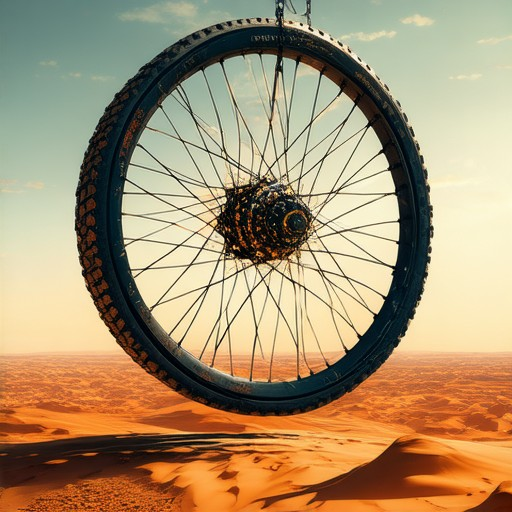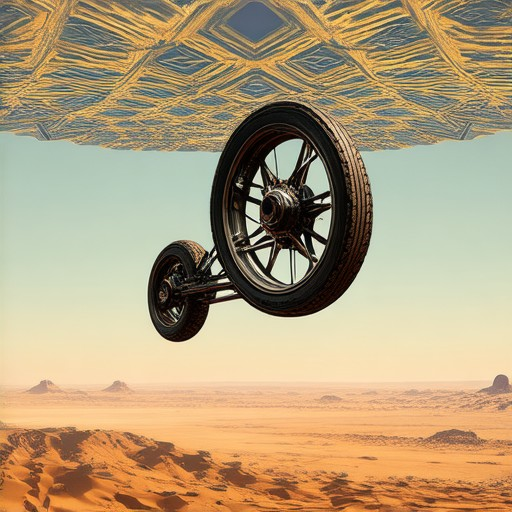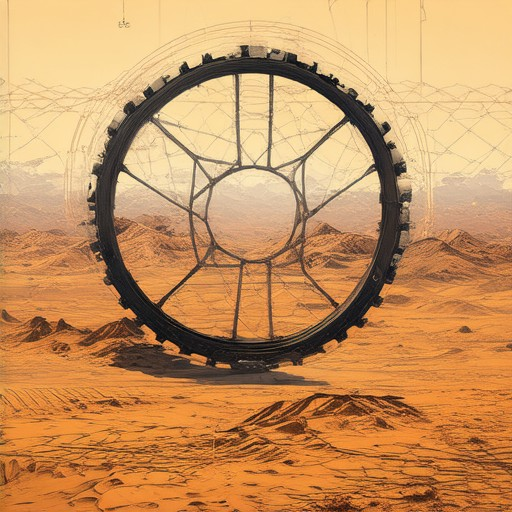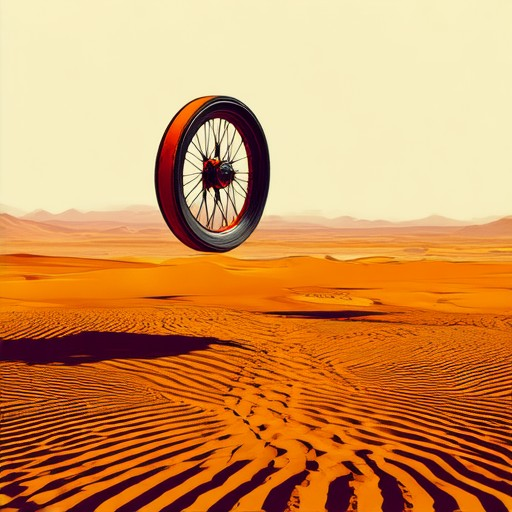Exploring the vast expanse of desert landscapes, where every mile is a testament to nature’s resilience, one cannot overlook the significance of specialized wheels designed to navigate such harsh environments. Whether you’re an enthusiast, a hobbyist, or simply curious about the intricacies of desert exploration, understanding the unique features and benefits of wheels tailored for desert terrain is essential. These wheels are crafted not just for functionality but also for aesthetic appeal, blending durability with style to conquer the most challenging terrains. From intricate textures to versatile designs, wheels for desert terrain offer a blend of performance and visual interest, making them a fascinating subject for collectors and enthusiasts alike. This article delves into the key features, design elements, and applications of wheels specifically engineered for desert conditions, providing insights into what makes them stand out in the world of miniature and scale modeling.
Key Takeaways
- Larger Diameter and Wider Profiles: Wheels designed for desert terrain feature larger diameters and wider profiles, enhancing stability and preventing vehicles from sinking into soft sand, ensuring better traction and control.
- Bead Locks: Securely attach wheels to hubs with robust bolts, allowing for quick and tool-free tire changes, ideal for off-road adventures.
- Low-Pressure Inflation Systems: Adjust tire pressure precisely for navigating rocky terrains and avoid bogging down in loose sand, with some models offering remote adjustments via smartphone apps.
- Rim Protectors: Protect wheels from damage caused by rocks and stumps, safeguarding the integrity of the rim and reducing repair costs.
- Aggressive Tread Patterns: Provide superior traction by channeling sand away from tires and dissipating heat, preventing slippage in hot conditions.
- Specialized Rubber Compositions: Offer flexibility in extreme temperatures and resistance to cracking, ensuring reliability in harsh desert environments.
- Sand Retention Features: Help trap sand within the tread, minimizing damage from flying particles and improving vehicle stability.
- Longer Spoke Lengths: Increase strength and flexibility, accommodating the stresses of rough terrain without risking spoke fractures.
- Brand Recommendations: Consider brands like Method Wheels, Mickey Thompson, and KMC Wheels for durable and specialized desert wheels.

What are the key features of wheels specifically designed for desert terrain?
Deep Tread Patterns
Desert terrain wheels often feature aggressive tread patterns designed to maximize traction on loose, sandy surfaces. These patterns typically consist of deep grooves and angular lugs that dig into the ground, preventing the wheels from slipping during acceleration or braking.
Wide Wheel Profiles
Wide wheel profiles are essential for desert driving as they provide a larger contact area with the ground. This increased surface area helps distribute weight more evenly and reduces the likelihood of the vehicle getting stuck in soft sand or mud.
Robust Construction
Construction-wise, desert wheels are built to withstand harsh conditions. They often feature reinforced sidewalls and durable materials to prevent punctures, tears, or impacts from sharp objects common in desert environments.
Customization Options
Many manufacturers offer customizable options, allowing drivers to tailor the wheels to their specific needs. This includes adjusting tread depth, width, and even adding protective features like rock guards or armor plating for added durability in rough terrain.
Large Diameter Sizes
Desert wheels typically come in larger diameter sizes, ranging from 16 inches upwards. Larger diameters increase stability, especially when navigating uneven surfaces, and provide better clearance for obstacles like rocks or sand dunes.
Lightweight Construction
While not all desert wheels are lightweight, many are designed with lighter materials to improve fuel efficiency and reduce strain on vehicles with limited power. This is particularly important for long-distance desert traversals.
Competitor Options
When considering desert-specific wheels, brands like Method Wheels , Mickey Thompson , and KMC Wheels also offer excellent options tailored for desert conditions. Each brand brings its own unique design philosophies and technologies to the table, ensuring a wide variety of choices for enthusiasts.
Ultimately, the best choice depends on individual driving preferences, vehicle requirements, and budget considerations. Whether you prioritize durability, traction, or aesthetic appeal, there’s a desert wheel solution to suit your needs.
What are the key design features of wheels specifically designed for desert terrain?
- Beadlock Rings: Many desert terrain wheels come equipped with beadlock rings, which secure the wheel to the hub. These rings provide added strength and prevent the wheel from coming loose, essential for rough terrain.
- Aggressive Tread Patterns: Desert wheels often feature deep, chunky tread patterns designed to maximize grip on sandy or loose surfaces. This enhances stability and prevents slipping.
- Lightweight Construction: While not all desert wheels are lightweight, many are constructed with materials that reduce weight without compromising strength, making them easier to handle on long rides.
- Reinforced Structures: Wheels designed for deserts often have reinforced sidewalls to protect against punctures and impacts from sharp objects like rocks or cacti.
- Suspension Compatibility: Some desert wheels are specifically designed to work with off-road suspensions, offering better handling and shock absorption on uneven terrains.
- Large Diameter: Larger wheels with wider rims are common in desert designs, providing greater surface area for better grip and reducing the likelihood of getting stuck in soft sand.
- Durable Materials: High-quality materials like aluminum or carbon fiber are frequently used in desert wheels to ensure they can withstand extreme temperatures and harsh conditions.
- Threaded or Flanged Hubs: Many desert wheels come with threaded or flanged hubs that allow for easy installation of additional accessories like locking nuts or skid plates, enhancing functionality and safety.
These design features work together to provide maximum traction, durability, and control in demanding desert environments. Whether you’re racing through dunes or navigating rocky trails, the right desert-specific wheels can make all the difference in comfort and performance.

What are the key features of wheels specifically designed for desert terrain?
Deep Tread Patterns
Desert terrain wheels often feature aggressive tread patterns designed to maximize traction on loose, sandy surfaces. These patterns typically consist of deep grooves and angular lugs that dig into the ground, preventing the wheels from slipping during acceleration or braking.
Wide Wheel Profiles
Wide wheel profiles are essential for desert driving as they provide a larger contact area with the ground. This increased surface area helps distribute weight more evenly and reduces the likelihood of the vehicle getting stuck in soft sand or mud.
Robust Construction
Construction-wise, desert wheels are built to withstand harsh conditions. They often feature reinforced sidewalls and durable materials to prevent punctures, tears, or impacts from sharp objects common in desert environments.
Customization Options
Many manufacturers offer customizable options, allowing drivers to tailor the wheels to their specific needs. This includes adjusting tread depth, width, and even adding protective features like rock guards or armor plating for added durability in rough terrain.
Large Diameter Sizes
Desert wheels typically come in larger diameter sizes, ranging from 16 inches upwards. Larger diameters increase stability, especially when navigating uneven surfaces, and provide better clearance for obstacles like rocks or sand dunes.
Lightweight Construction
While not all desert wheels are lightweight, many are designed with lighter materials to improve fuel efficiency and reduce strain on vehicles with limited power. This is particularly important for long-distance desert traversals.
Competitor Options
When considering desert-specific wheels, brands like Method Wheels , Mickey Thompson , and KMC Wheels also offer excellent options tailored for desert conditions. Each brand brings its own unique design philosophies and technologies to the table, ensuring a wide variety of choices for enthusiasts.
Ultimately, the best choice depends on individual driving preferences, vehicle requirements, and budget considerations. Whether you prioritize durability, traction, or aesthetic appeal, there’s a desert wheel solution to suit your needs.

Essential Features of Desert Terrain Wheels
- Larger Diameter and Wider Profiles: Wheels designed for desert terrain often feature larger diameters and wider profiles. This configuration enhances stability and prevents the vehicle from sinking into soft sand, providing better traction and control.
- Bead Locks: Many desert-specific wheels come with bead locks, which are robust bolts that secure the wheel to the hub. These locks offer exceptional strength and allow for quick and easy tire changes without the need for tools, making them ideal for off-road adventures.
- Low-Pressure Inflation Systems: Some desert wheels are equipped with low-pressure inflation systems. These systems allow for precise adjustment of tire pressure, which is crucial for navigating rocky terrains and avoiding bogging down in loose sand. Some even feature remote adjustment capabilities via smartphone apps.
- Rim Protectors: To protect against potential damage from rocks and stumps, many desert wheels come with rim protectors. These guards help preserve the integrity of the wheel’s rim, reducing the risk of costly repairs and ensuring longevity.
- Aggressive Tread Patterns: The tread on desert wheels is typically more aggressive, featuring deep grooves and chunky lugs. This design effectively channels sand away from the tire, maintaining traction and preventing the tire from becoming clogged with debris. Additionally, the tread is often designed to dissipate heat, reducing the risk of slipping in hot conditions.
- Specialized Rubber Compositions: Desert wheels may utilize unique rubber formulations that offer flexibility in extreme temperatures and resistance to cracking. This ensures reliability and performance in the harsh conditions commonly found in desert environments.
- Sand Retention Features: Some wheels incorporate sand retention designs, such as indentations or patterns, to better hold sand in place. This helps prevent sand from being kicked up and thrown at the vehicle, minimizing potential damage from flying particles.
- Longer Spoke Lengths: Longer spokes are often used in desert wheels to accommodate greater flexibility without risking spoke fractures. This added strength ensures the wheels can handle the stresses of rough terrain without failing.
These features collectively contribute to the durability, performance, and adaptability of wheels specifically engineered for desert terrain, ensuring optimal handling in challenging conditions.
What are the key features of wheels specifically designed for desert terrain?
Deep Tread Patterns
Desert terrain wheels often feature aggressive tread patterns designed to maximize traction on loose, sandy surfaces. These patterns typically consist of deep grooves and angular lugs that dig into the ground, preventing the wheels from slipping during acceleration or braking.
Wide Wheel Profiles
Wide wheel profiles are essential for desert driving as they provide a larger contact area with the ground. This increased surface area helps distribute weight more evenly and reduces the likelihood of the vehicle getting stuck in soft sand or mud.
Robust Construction
Construction-wise, desert wheels are built to withstand harsh conditions. They often feature reinforced sidewalls and durable materials to prevent punctures, tears, or impacts from sharp objects common in desert environments.
Customization Options
Many manufacturers offer customizable options, allowing drivers to tailor the wheels to their specific needs. This includes adjusting tread depth, width, and even adding protective features like rock guards or armor plating for added durability in rough terrain.
Large Diameter Sizes
Desert wheels typically come in larger diameter sizes, ranging from 16 inches upwards. Larger diameters increase stability, especially when navigating uneven surfaces, and provide better clearance for obstacles like rocks or sand dunes.
Lightweight Construction
While not all desert wheels are lightweight, many are designed with lighter materials to improve fuel efficiency and reduce strain on vehicles with limited power. This is particularly important for long-distance desert traversals.
Competitor Options
When considering desert-specific wheels, brands like Method Wheels , Mickey Thompson , and KMC Wheels also offer excellent options tailored for desert conditions. Each brand brings its own unique design philosophies and technologies to the table, ensuring a wide variety of choices for enthusiasts.
Ultimately, the best choice depends on individual driving preferences, vehicle requirements, and budget considerations. Whether you prioritize durability, traction, or aesthetic appeal, there’s a desert wheel solution to suit your needs.

What Characteristics Make Wheels Specifically Designed for Desert Terrain Effective?
- Large Wheel Size: Desert terrain wheels typically feature larger diameters compared to standard wheels. This increased size provides greater surface area for better grip and prevents the wheels from sinking into soft sand.
- Reinforced Construction: These wheels are built to withstand harsh desert conditions, often featuring thick rims and reinforced structures to protect against sharp rocks and other obstacles.
- Aggressive Tread Design: The tread patterns on desert-specific wheels are designed to maximize traction. Deep, aggressive treads help dig into the sand, providing better grip and preventing slippage.
- Sand-Retaining Designs: Many desert wheels incorporate features like beadlocks or ribbed edges that help trap sand within the tread, preventing it from causing vibrations or loosening the connection between the tire and rim.
- Temperature Resistance: Specialized valve stems and materials allow these wheels to handle extreme heat, ensuring they remain functional in scorching desert conditions.
Competitors in the market include brands like Method Race Wheels and Mickey Thompson , who also offer comparable products tailored for desert environments.
Conclusion
Incubus Wheels offers a robust solution for desert terrain challenges with its combination of size, strength, traction, and sand management features. These characteristics work together to deliver optimal performance in demanding off-road conditions, making them a reliable choice for enthusiasts navigating desert trails.




0 Comments